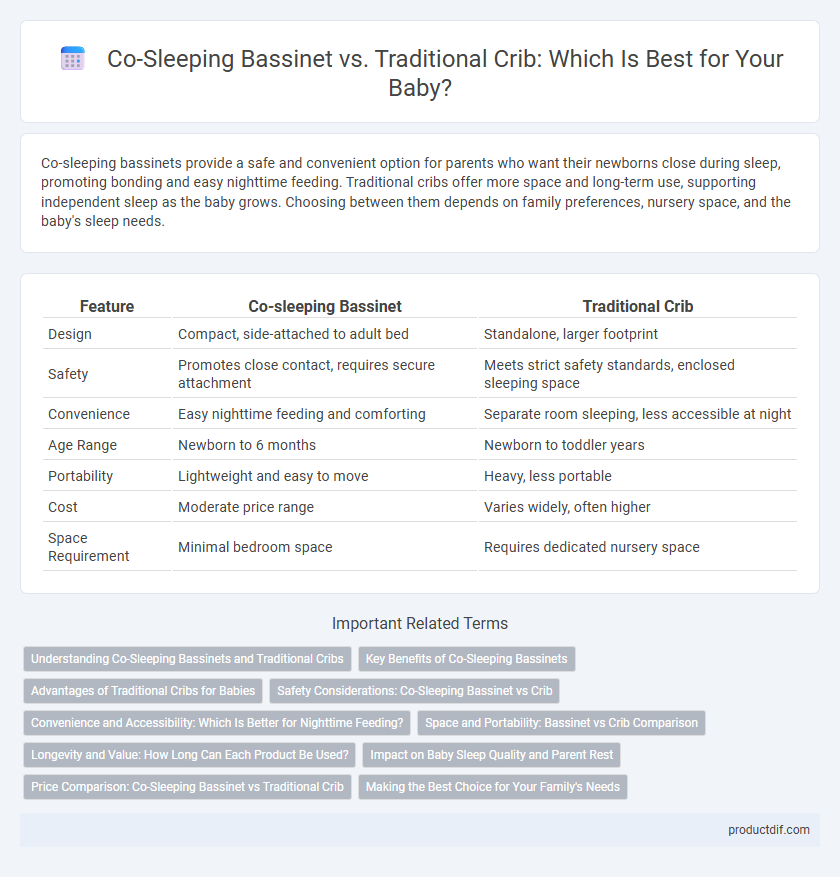Co-sleeping bassinets provide a safe and convenient option for parents who want their newborns close during sleep, promoting bonding and easy nighttime feeding. Traditional cribs offer more space and long-term use, supporting independent sleep as the baby grows. Choosing between them depends on family preferences, nursery space, and the baby's sleep needs.
Table of Comparison
| Feature | Co-sleeping Bassinet | Traditional Crib |
|---|---|---|
| Design | Compact, side-attached to adult bed | Standalone, larger footprint |
| Safety | Promotes close contact, requires secure attachment | Meets strict safety standards, enclosed sleeping space |
| Convenience | Easy nighttime feeding and comforting | Separate room sleeping, less accessible at night |
| Age Range | Newborn to 6 months | Newborn to toddler years |
| Portability | Lightweight and easy to move | Heavy, less portable |
| Cost | Moderate price range | Varies widely, often higher |
| Space Requirement | Minimal bedroom space | Requires dedicated nursery space |
Understanding Co-Sleeping Bassinets and Traditional Cribs
Co-sleeping bassinets are designed to attach securely to an adult bed, allowing babies to sleep close to parents while maintaining a separate sleep space, which supports breastfeeding and nighttime monitoring. Traditional cribs offer a standalone, enclosed sleeping area with high safety standards and adjustable mattress heights, promoting independent sleep habits. Understanding the differences in design, safety features, and parental accessibility helps caregivers choose the ideal sleep environment for their infant's safety and comfort.
Key Benefits of Co-Sleeping Bassinets
Co-sleeping bassinets offer enhanced proximity between parent and baby, promoting easier nighttime feeding and comforting, which supports better sleep patterns for both. Their compact design fits securely next to the bed, reducing the risk of accidental separation while maintaining safe boundaries. These bassinets also encourage bonding and can help parents quickly respond to baby's needs without fully waking.
Advantages of Traditional Cribs for Babies
Traditional cribs offer a spacious, secure sleeping environment that promotes healthy infant development by allowing more room for movement and reducing the risk of overheating. Their sturdy construction and fixed sides provide enhanced safety and durability compared to co-sleeping bassinets. Many traditional cribs meet stringent safety standards and often include adjustable mattress heights to accommodate growing babies, supporting long-term use.
Safety Considerations: Co-Sleeping Bassinet vs Crib
Co-sleeping bassinets offer a safer alternative to traditional cribs by allowing close proximity between parent and baby without the risk of entrapment or suffocation associated with shared beds. Cribs provide a firm, enclosed sleeping environment that meets established safety standards, reducing the risk of Sudden Infant Death Syndrome (SIDS) when used correctly. Selecting a product certified by organizations like the Juvenile Products Manufacturers Association (JPMA) ensures compliance with rigorous safety guidelines for either option.
Convenience and Accessibility: Which Is Better for Nighttime Feeding?
Co-sleeping bassinets offer unparalleled convenience for nighttime feeding by positioning the baby within arm's reach, allowing parents to easily nurse or soothe without fully waking or leaving the bed. Traditional cribs, often placed across the room, require parents to physically get up, which can disrupt sleep cycles and extend feeding times. For accessibility and quick response during night feedings, co-sleeping bassinets typically provide a more practical and ergonomic solution.
Space and Portability: Bassinet vs Crib Comparison
Co-sleeping bassinets offer superior portability and compact design, making them ideal for small spaces and easy room-to-room movement. Traditional cribs provide a larger, stationary sleeping area but require significantly more floor space and are less convenient to relocate. Parents seeking space-saving solutions often prefer bassinets for their lightweight structure and foldable features.
Longevity and Value: How Long Can Each Product Be Used?
Co-sleeping bassinets are designed for newborns up to about six months, limiting their use to the early months of an infant's life, while traditional cribs offer longevity, accommodating children up to three to five years or longer with adjustable mattress heights and convertible features. Investing in a traditional crib provides more value over time, supporting growth stages from infancy through toddlerhood, whereas co-sleeping bassinets serve a shorter-term purpose primarily focused on newborn safety and convenience. Parents seeking long-term functionality will benefit more from a durable crib that adapts to the child's development and sleeping needs.
Impact on Baby Sleep Quality and Parent Rest
Co-sleeping bassinets promote easier nighttime breastfeeding and closer proximity, which can enhance baby sleep quality by reducing awakenings and promoting longer sleep cycles. Traditional cribs offer a separate sleep environment that may encourage early independent sleep habits but can lead to more frequent night waking for both baby and parents. Parents using co-sleeping bassinets often experience improved rest due to minimized disruptions, while those relying on traditional cribs may face increased nocturnal caregiving demands that impact their overall sleep quality.
Price Comparison: Co-Sleeping Bassinet vs Traditional Crib
Co-sleeping bassinets typically range from $80 to $250, making them a more budget-friendly option compared to traditional cribs, which usually cost between $150 and $500. The lower price of co-sleeping bassinets often reflects their smaller size and simpler design, while traditional cribs offer more durability and longevity, sometimes converting into toddler beds for extended use. Parents should weigh immediate costs against long-term utility when choosing between these two baby sleep solutions.
Making the Best Choice for Your Family's Needs
Choosing between a co-sleeping bassinet and a traditional crib depends on factors like available space, ease of nighttime feeding, and your baby's sleep patterns. Co-sleeping bassinets offer proximity for bonding and convenience during night feedings, while traditional cribs provide a separate sleeping space that encourages independent sleep habits. Evaluating your family's lifestyle, safety preferences, and the baby's age will help determine the ideal sleep arrangement that supports both comfort and safety.
Co-sleeping bassinet vs traditional crib Infographic

 productdif.com
productdif.com